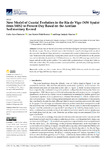New Model of Coastal Evolution in the Ria de Vigo (NW Spain) from MIS2 to Present Day Based on the Aeolian Sedimentary Record

Use este enlace para citar
http://hdl.handle.net/2183/31843
Excepto si se señala otra cosa, la licencia del ítem se describe como Atribución 4.0 Internacional (CC BY 4.0)
Colecciones
- Investigación (FCIE) [1225]
Metadatos
Mostrar el registro completo del ítemTítulo
New Model of Coastal Evolution in the Ria de Vigo (NW Spain) from MIS2 to Present Day Based on the Aeolian Sedimentary RecordFecha
2022Cita bibliográfica
Arce-Chamorro, C.; Vidal-Romaní, J.R.; Sanjurjo-Sánchez, J. New Model of Coastal Evolution in the Ria de Vigo (NW Spain) from MIS2 to Present Day Based on the Aeolian Sedimentary Record. J. Mar. Sci. Eng. 2022, 10, 1350. https://doi.org/10.3390/jmse10101350
Resumen
[Abstract] Galician Rias are fluvial valleys that were flooded during the last marine transgression in the Atlantic margin. The study of fossil dunes in the Cies Islands, a small archipelago in the mouth of the one of the rias (Ria de Vigo), allowed us to reconstruct the coastal evolution from the end of the Late Pleistocene to the present day. During this period, sea-level was 100 metres below the present one and the shoreline located about 5–10 kilometres away. About 15,000 years ago, sea-level rise began, radically modifying the coastline. This started with a gradual advance of large dune fields on both sides of the valley. The aeolian accretion continued until the Late Holocene, finishing when the sea reached its present level.
Palabras clave
Aeolian accretion
Coastal dunes
OSL-dating
MIS2
Holocene
Sea-level
Submerged forest
Ria de Vigo
NW Iberian Atlantic coast
Coastal dunes
OSL-dating
MIS2
Holocene
Sea-level
Submerged forest
Ria de Vigo
NW Iberian Atlantic coast
Descripción
This article belongs to the Special Issue Recent Advances in Geological Oceanography
Versión del editor
Derechos
Atribución 4.0 Internacional (CC BY 4.0)
ISSN
2077-1312






